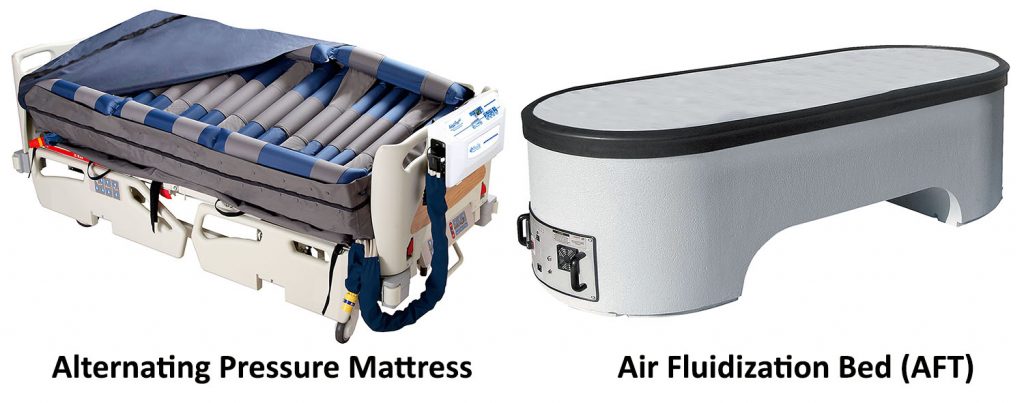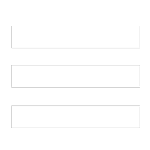The difference between Alternating Pressure and Air Fluidized Therapy AFT

COMMON USE
ALTERNATING PRESSURE Prevention & Treatment of Stages I-IV Pressure Injury
AIR FLUIDIZED THERAPY Treatment of Stages III-IV Pressure Injury, burns, flap surgeries, grafts & unstageable wounds
Both AFT and Alternating Pressure therapy are for the treatment of late-stage pressure sores. There are benefits and restrictions to each therapy. However, where, when, and how each therapeutic mattress is utilized is often misunderstood. This article explores those factors to give the reader a greater understanding.
Similar to Alternating Pressure, Air Fluidized Therapy (AFT) is for the treatment of Stages III-IV pressure injuries. However, because AFT provides better pressure redistribution and immersion than alternating pressure, it is utilized for more advanced wounds including unstageable wounds, burns, post graft, and post flap wounds. While it seems logical to select AFT over alternating pressure for the treatment of stage III-IV pressure sores, Air-Fluidized Therapy has many downsides. These must be taken into consideration when selecting a support surface for the treatment of Stages III-IV pressure sores.
Blood flow is essential to keep the skin healthy and for wound healing. The goal of AFT and Alternating Pressure is to improve blood flow to the skin. Both therapies help to alleviate unrelieved pressure by pressure redistribution and the reduction of interface pressures between the body and the mattress. Additionally, both therapies create a healthy micro-climate via low air loss to help control the heat and moisture that can make the skin prone to breakdown. How each therapy achieves these goals is different.
ALTERNATING PRESSURE LOW AIR LOSS MATTRESS SYSTEM
An Alternating Pressure Mattress is constructed of a series of air bladders the width of the mattress whose internal pressures “alternate” in timed cycles. The internal air pressures are controlled by an alternating pressure pump and set according to patient weight and comfort. Many of the mattress bladders are ventilated to allow for the gentle flow of moisture and heat-reducing air.
How Alternating Pressure Mattress Systems Work
Basically, an alternating pressure mattress is comprised of two sets of air bladders in a series, an odd series (bladders 1,3,5,7,9, etc.) and an even series (2,4,6,8, 10, etc.). While the odd series bladders are inflated and firm, the even series bladders deflate and soften. In 10-minute cycles the soft bladders become firm and the firm bladders become soft. This continually provides pressure redistribution between the body and the mattress, to help prevent and treat pressure injuries and diabetic wounds. Where and how the body is supported changes. Additionally, Alternating Pressure helps improve blood flow through a process called Reactive Hyperemia. Low Air Loss therapy is achieved through lasered holes in the bladders that allow air to gently escape.
In more advanced mattress systems such as Blue Chip Medical’s Adapt Pro Elite, the low air loss function is built into the cover thereby enhancing the low air loss therapy. Furthermore, these quality systems offer immersion therapy via a pulsation mode.
PRO
– Prevention and treatment of stages I-IV pressure wounds
– Excellent pressure redistribution
– Enhanced Low Air Loss Therapy
– Immersion therapy via pulsation mode
– Available in a greater range of mattress sizes to fit standard hospital bed frames
– Models to support bariatric weights up to and including up to 1000 lbs.
– Suitable for a more diverse patient population for size and weight.
– Surface stability and balance
– Adjustable patient comfort
– Automated features provide optimal therapy & require less caregiver training
– Low Maintenance
– Ease of transfers & patient care
– Offers full body therapy in Fowler position
– Low cost of acquisition and operation
– Possible use for post flap & post graft wounds
DISADVANTAGE
– Not suited for burns
AIR FLUIDIZED THERAPY (AFT)
An air-fluidized bed is commonly referred to as a sand or bead bed. There are full-body AFT and partial-body AFT therapy bed frames. On a full-body AFT bed, the patient must lay flat and rely on a wedge to achieve an incline position at the head of the bed (Fowler). A partial body frame provides the ability to incline the head of the bed however, limits the therapeutic area.
How do Air Fluidized Beds Work?
An Air Fluidized Bed is filled with approximately 1200 lbs. or more silicone beads. A powerful air pump blows air through the beads. The silicone beads rotate and frack essentially giving the beads the properties of a fluid, hence the term “Air Fluidization”. Air Fluidization therapy allows for immersion and envelopment of the patient into the surface and the equalization and reduction of interface pressures across the weight-bearing surfaces of the body. The powerful airflow rises through the cover to help keep the patient’s skin cool and dry.
PRO
– Advanced pressure redistribution for treatment of late-stage pressure injuries
– Appropriate for unstageable wounds
– Appropriate for burns
– Use for post flap & post graft wounds
– True Low Air Loss Therapy
– Excellent immersion therapy
DISADVANTAGE
– Patient dehydration due to high heat and airflow
– Difficulty with patient transfer and care
– May require a patient lifter for transfer
– Surface instability makes patient positioning difficult
– Weight of the bed and beds can exceed 1500 lbs or more
– Disinfection and cleaning of the beads
– Not easily suited for home use
– Can increase the ambient room temperature up to 10-15 degrees or more
– Cleanliness
– Maintenance
– Caregiver Safety
– Significantly High Cost generally for rental
Patient dehydration
In an already difficult recovery process, dehydration due to the high heat of air fluidization can affect healing and be very problematic for the patient.
Patient transfer & care
Since the patient can immerse in the surface, it can be difficult for a caregiver to reposition the patient for care or transfer. In many cases, the use of a patient lifter is required.
Surface instability & patient positioning
Due to the instability of the silicon bead medium, the surface can interfere with patient repositioning, Fowler positioning, and side-lying.
Weight of the bed for home use
The AFT bed is filled with approximately 1200 lbs or more of silicone beads. The full weight of the bed without a patient is approximately 1,500 lbs. This is often too much weight for home use. AFT should only be used on a supported first floor.
Cleaning and disinfecting of the beads
There are approximately 1200 lbs. of silicone beads that require cleaning and disinfection. If a patient is incontinent, body fluids, urine, and feces can infiltrate the cover. This requires the beads to be disinfected, normally monthly or sooner depending on the patient. Disinfecting the beads requires the beads to “cook” for 12 hours and then cool. Some AFT systems can clean and disinfect while others require a second piece of disinfection equipment called a bead cooker. In either case, the patient must be transferred from the bed and placed on an alternate therapeutic surface for the entire duration of the disinfection process (12 hours to cook and 12 hours to cool).
Disinfection through the use of special equipment requires up to 1,200 lbs of the beads to be removed from the bed. The clumped silicone “cookies” must be sifted and removed. The balance of the sifted beads is then placed into the disinfection equipment and “cooked” for approximately 12 hours. The beads are then cooled for as long as 12 hours before they can be replaced. To reduce patient handling and discomfort, another option is to have a second set of clean beads ready to be placed into the bed, while the soiled beads are being cleaned and disinfected. Cleaning is time-consuming, interferes with patient therapy, and is costly in energy use.
Ambient Temperature
While the temperature of the air flowing through the beads can to some degree be adjusted, the powerful air pump generates a lot of heat. This excess heat can increase the ambient room temperature up to 10 – 15 degrees or more in an already warm environment. This may require air conditioning to counteract the high room temperature to keep the patient comfortable.
Cleanliness, Caregiver Safety & Maintenance
The silicone beads often become airborne. They dirty all surfaces including the floor. Since the beads are slippery, this increases the possibility that a caregiver or patient may slip and fall. Cleaning and maintenance must be conducted on a regular basis.
Cost
AFT beds often range from $35,000 – $65,000 plus the cost of the beads and disinfection equipment. This is greater than 10 times the cost of a high-quality Alternating Pressure Mattress System ranging from $2,800 – $4,500. There are recurring maintenance costs for AFT. Even the monthly rental costs for AFT are very expensive.
Why it Matters?
Before selecting Air Fluidized Therapy for home use one must weigh the benefits and drawbacks: negative effects of possible patient dehydration and position in an already compromised patient, the amount of maintenance, cleanliness, and quality of care required for effective Air Fluidized Therapy, weight limitation of existing structure, environmental factors, cost and more.
Conclusion
Air Fluidized Therapy offers more advanced pressure redistribution, immersion, and air loss therapy, for the treatment of Stages III-IV pressure sores. However, alternatives such as a high-quality, hospital-grade Alternating Pressure Low Air Loss Mattress system should be considered, even for postflap or postgraft patients.


 MENU
MENU







